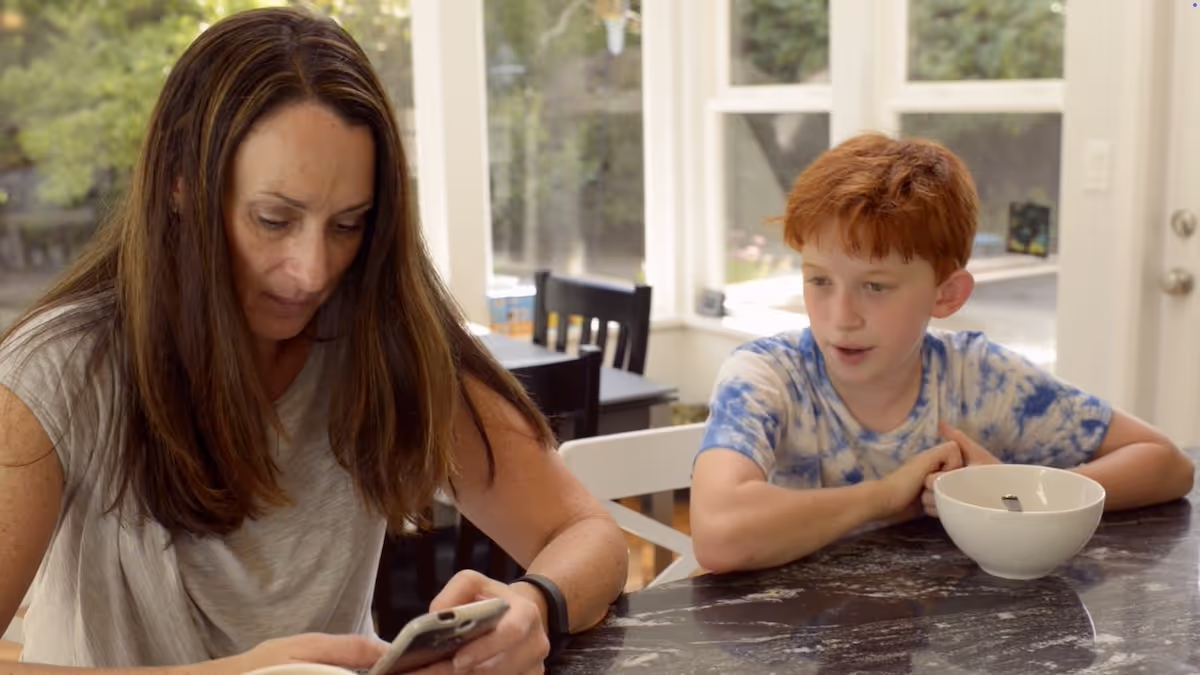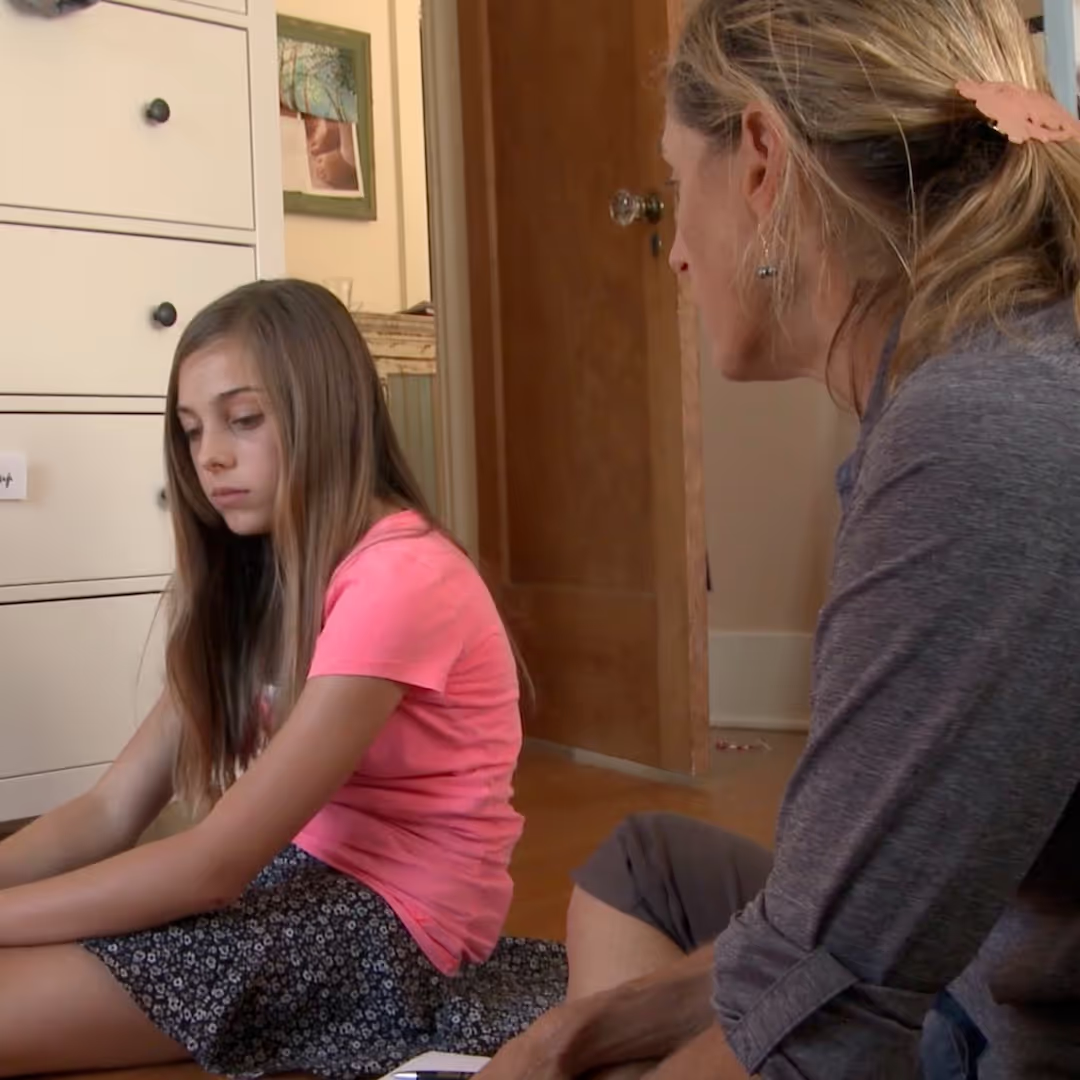


Why have any screen time policies /rules for our kids anyway? Devices provide endless entertainment, connection to others, relief from FOMO, a sense of competency that comes from leveling up in a game, and much more. But at a cost. Allowing the “treat” side of tech (vs. the “tool” side) to overly consume our children’s time is not in their best interest, nor that of our families or schools.
That’s why having policies /rules around tech is valuable and worth the work. But I am the last to claim that this is easy. You may know my personal story from Screenagers, where you saw me learning the hard way how critical it is to find ways to involve our kids in defining screen-time rules with us vs. my initial, more top-down techniques.
At times your kids may want to refrain from participating. But don’t give up. Make sure you have some protected time to talk about science, love, and all the reasons why this is important.
Katherine Milkman, a researcher, and author of How To Change, has found that people are particularly motivated to change behaviors after a “fresh start,” such as the New Year or the start of a new month. As humans, we love the idea of a clean slate.
A couple of headlines are making their way through the press, and while you may want to share them with your kids, be sure to be clear that these are association studies. What to make of each association will take time to decipher, so we must be careful to avoid drawing conclusions prematurely. These findings include associations between video gaming and obsessive-compulsive disorder and between social media and cognitive control.
These papers come from the ABCD study, a coalition of researchers across the country studying kids over time and doing brain scans. We will continue to see more headlines about these associations.
Below are eleven tech-policy examples to consider talking about with your kids and making some decisions. As a parent, you may need to make some executive decisions if you can’t agree on things together.
Finally, deciding on policies depends on many things, like your child’s age, so I’ve provided different variations.
Learn more about showing our movies in your school or community!
Join Screenagers filmmaker Delaney Ruston MD for our latest Podcast

Learn more about our Screen-Free Sleep campaign at the website!
Our movie made for parents and educators of younger kids
Learn more about showing our movies in your school or community!
This involves having your teen scroll on their social media for a few minutes while you sit with them. You get to see what comes up and you don’t react or critique, just observe. And then a day or two later is when you can reconvene to debrief a bit. Not to be judgmental or mad, but to think together about some messages and dynamics you both noticed on your teen's social media.
Pointer: try to schedule a day, like the first of each month, in which this will occur somewhat regularly.
a. Agree on a time to share findings, such as at two dinners from now
b. Determine the method for tracking screen time that works best:
c. Each family member records their own screen time using the chosen method.
d. At the agreed time, share findings with the rest of the family.
Learn more about showing our movies in your school or community!
Join Screenagers filmmaker Delaney Ruston MD for our latest Podcast

Learn more about our Screen-Free Sleep campaign at the website!
Our movie made for parents and educators of younger kids
Join Screenagers filmmaker Delaney Ruston MD for our latest Podcast
As we’re about to celebrate 10 years of Screenagers, we want to hear what’s been most helpful and what you’d like to see next.
Please click here to share your thoughts with us in our community survey. It only takes 5–10 minutes, and everyone who completes it will be entered to win one of five $50 Amazon vouchers.
Why have any screen time policies /rules for our kids anyway? Devices provide endless entertainment, connection to others, relief from FOMO, a sense of competency that comes from leveling up in a game, and much more. But at a cost. Allowing the “treat” side of tech (vs. the “tool” side) to overly consume our children’s time is not in their best interest, nor that of our families or schools.
That’s why having policies /rules around tech is valuable and worth the work. But I am the last to claim that this is easy. You may know my personal story from Screenagers, where you saw me learning the hard way how critical it is to find ways to involve our kids in defining screen-time rules with us vs. my initial, more top-down techniques.
At times your kids may want to refrain from participating. But don’t give up. Make sure you have some protected time to talk about science, love, and all the reasons why this is important.
Katherine Milkman, a researcher, and author of How To Change, has found that people are particularly motivated to change behaviors after a “fresh start,” such as the New Year or the start of a new month. As humans, we love the idea of a clean slate.
A couple of headlines are making their way through the press, and while you may want to share them with your kids, be sure to be clear that these are association studies. What to make of each association will take time to decipher, so we must be careful to avoid drawing conclusions prematurely. These findings include associations between video gaming and obsessive-compulsive disorder and between social media and cognitive control.
These papers come from the ABCD study, a coalition of researchers across the country studying kids over time and doing brain scans. We will continue to see more headlines about these associations.
Below are eleven tech-policy examples to consider talking about with your kids and making some decisions. As a parent, you may need to make some executive decisions if you can’t agree on things together.
Finally, deciding on policies depends on many things, like your child’s age, so I’ve provided different variations.
This involves having your teen scroll on their social media for a few minutes while you sit with them. You get to see what comes up and you don’t react or critique, just observe. And then a day or two later is when you can reconvene to debrief a bit. Not to be judgmental or mad, but to think together about some messages and dynamics you both noticed on your teen's social media.
Pointer: try to schedule a day, like the first of each month, in which this will occur somewhat regularly.
a. Agree on a time to share findings, such as at two dinners from now
b. Determine the method for tracking screen time that works best:
c. Each family member records their own screen time using the chosen method.
d. At the agreed time, share findings with the rest of the family.
Sign up here to receive the weekly Tech Talk Tuesdays newsletter from Screenagers filmmaker Delaney Ruston MD.
We respect your privacy.
Why have any screen time policies /rules for our kids anyway? Devices provide endless entertainment, connection to others, relief from FOMO, a sense of competency that comes from leveling up in a game, and much more. But at a cost. Allowing the “treat” side of tech (vs. the “tool” side) to overly consume our children’s time is not in their best interest, nor that of our families or schools.
That’s why having policies /rules around tech is valuable and worth the work. But I am the last to claim that this is easy. You may know my personal story from Screenagers, where you saw me learning the hard way how critical it is to find ways to involve our kids in defining screen-time rules with us vs. my initial, more top-down techniques.
At times your kids may want to refrain from participating. But don’t give up. Make sure you have some protected time to talk about science, love, and all the reasons why this is important.
Katherine Milkman, a researcher, and author of How To Change, has found that people are particularly motivated to change behaviors after a “fresh start,” such as the New Year or the start of a new month. As humans, we love the idea of a clean slate.
A couple of headlines are making their way through the press, and while you may want to share them with your kids, be sure to be clear that these are association studies. What to make of each association will take time to decipher, so we must be careful to avoid drawing conclusions prematurely. These findings include associations between video gaming and obsessive-compulsive disorder and between social media and cognitive control.
These papers come from the ABCD study, a coalition of researchers across the country studying kids over time and doing brain scans. We will continue to see more headlines about these associations.
Below are eleven tech-policy examples to consider talking about with your kids and making some decisions. As a parent, you may need to make some executive decisions if you can’t agree on things together.
Finally, deciding on policies depends on many things, like your child’s age, so I’ve provided different variations.


Parenting in this digital age is full of challenges. I imagine many of you are nodding in agreement. And when we look for advice online, it can feel like a sea of perfect experts with perfect advice: “Just follow these three easy steps and everything will fall into place.” In this week’s blog, I share a story about a moment with my daughter Tessa that did not go quite as planned but ended up teaching us both something important.
READ MORE >
Wow! Summer really goes by fast, doesn’t it? Back-to-school is already here for some and not far away for others. Ahead of this school year, I’ve hand-picked four of our most useful blogs. Practical, timely guides to help you set your family up for a healthier, more balanced relationship with technology in the months ahead.
READ MORE >for more like this, DR. DELANEY RUSTON'S NEW BOOK, PARENTING IN THE SCREEN AGE, IS THE DEFINITIVE GUIDE FOR TODAY’S PARENTS. WITH INSIGHTS ON SCREEN TIME FROM RESEARCHERS, INPUT FROM KIDS & TEENS, THIS BOOK IS PACKED WITH SOLUTIONS FOR HOW TO START AND SUSTAIN PRODUCTIVE FAMILY TALKS ABOUT TECHNOLOGY AND IT’S IMPACT ON OUR MENTAL WELLBEING.
